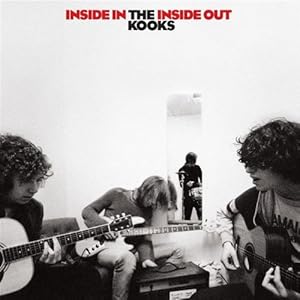
As it was outlined in my textual analysis of The 1975 -"Robbers" it is common for indie bands to experiment with more low key lighting to achieve a retro finish to their work, again, as is seen in promo's featuring The 1975 (a band who are similar in their indie appearance). All band members are pictured, the formation in which they are sat is particularly interesting - instead of having a picture of the band lined up side by side to fit all members in the frame comfortably, the band are photographed (what we presume) rehearsing, however, the angle at which the photo has been taken has been deliberately employed to maximize audience involvement. In essence, the album cover is designed to make us feel as if we are there with the band, in their presence, which evokes a sense of empathy from the consumer and outlines one of the main themes of the album: The Kooks are a band who formed at university and are ordinary people like those who will likely purchase the album, and the cover of the album supports this notion (the fact that it is their debut album suggests they have only experienced a small dose of fame - perhaps they were popular locally). The typography (which has become a commonality among indie bands) is made up of bold lettering to ensure the title of the album and the band name is unmistakable and embossed for consumer recognition. The album title Inside In Inside Out is given prominence by the striking rich red it is coloured in, only to be made more appealing by the relatively dull, light shade of grey in the backdrop. This makes the name of the album clear to the consumer and means the name will stick in the mind. The black and white effect used suggests nostalgic connotations and gives the album as a whole an anachronistic - essentially qualifying the artwork as 'postmodern': lead singer/songwriter Luke Pritchard cited 60's music as the primary influence on the album, and it is clear from the artwork that the design has made a return to more traditional materials and effects. The colour scheme and typography on the anterior of the album cover is used on all other panels of the digipak to keep it consistent. The album cover seems incredibly simple and it doesn't deliberately go for a particularly lavish appearance, and adheres to indie conventions of avoiding mainstream traits. As previously mentioned, The Kooks are aiming to target a demographic of young people in a similar position to themselves, possibly students with retro dress sense and passion for acoustic music. The fact each member of the band have averted their gaze from the camera connotes that they remain unfazed by media exposure and focus exclusively on making music, manifesting themselves as level headed. The photo of the band itself shows them sitting with each other making music without glamerous studios and recording equipment, a relatively simple environment; an area that could easily be described as a room in a university hall - which makes sense in the context of their target demographic and their social background. The mise en scene in the photo is also textbook indie: skinny (drainpipe) jeans and mop head hair; not too dissimilar to that of The Beatles, is an obvious denotation that the band remain loyal to the indie subculture.

